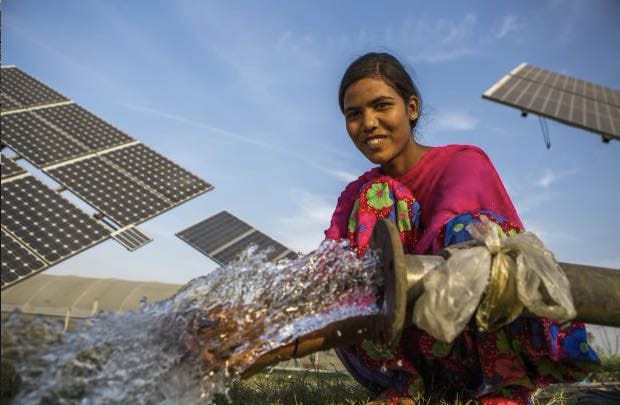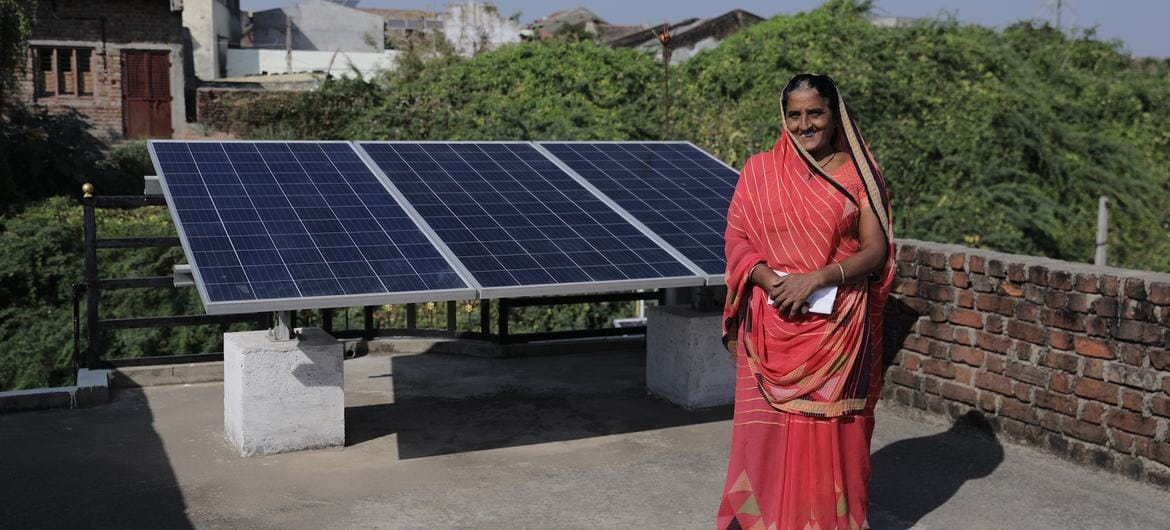There are tremendous socioeconomic payoffs for India when policies supporting its solar energy push embed gender diversity right from the start. Both goals of women-led development and decarbonisation can then be achieved simultaneously.
As of January 31, 2025 India’s total solar capacity installed stands at 100.33 GW. This includes a small but remarkable achievement of 4.59 GW of new rooftop solar capacity added in 2024 – a 53% rise from 2023. Meanwhile, over 6.1 lakh solar pumps were installed nationwide by December 2024 and 35 lakh grid-connected agriculture pumps were also solarised.
The government’s rooftop solar programme, PM Surya Ghar Muft Bijli Yojana, as well as PM KUSUM scheme for incentivising solar irrigation pumps have played a key role in scaling India’s solar capacity.
These programmes are a nod to the fact that Decentralised Renewable Energy (DRE) will be the cornerstone for India’s net zero emissions goal. Maximising our small scale generation capacity has the potential to make a big decarbonisation impact.
Last mile supply woes
Though most of India is connected to the grid, uninterrupted and reliable power supply is still rare. These gaps can be plugged by localised renewable power production using both grid-connected and off-grid solutions. Solar-powered instalments like household rooftop panels, microgrids or solar-operated infrastructure such as refrigeration units, pumps and lamps as well as battery storage will be the mainstay for such a decentralised network.
India needs nothing short of a revolution to meet its ambitious targets for net zero by 2070. In such expedited timelines, approaching power generation from a gender lens may seem like building obstacles to quick deployment. However, well designed policies can and do address both goals of environmental sustainability and equitable socioeconomic progress.
Policy makers must be strategic. While rapid installation and commission should be prioritised, state implementing agencies along with renewable energy training institutes and social sector organisations should mandatorily develop women community energy workers, engaging self help groups in the pursuit of energy transition.
Dawn of Usha Didis to take solar energy to the last mile
Like India met the challenge of taking healthcare to the last mile through ‘Asha didis’, a new tribe of ‘Usha didis’ may be what it takes to power India’s green transition movement. Roping in women for immunisation programmes, childcare, prenatal care and common ailments etc seems an obvious choice since they are the primary caregivers of a family. What should also be obvious is that women are closely involved in energy-dependent activities – from micro scale income generating work to household duties that include providing for the heating and cooling needs of homes, supervising the studies of children, or knitting and needlework.
Like India met the challenge of taking healthcare to the last mile through ‘Asha didis’, a new tribe of ‘Usha didis’ may be what it takes to power India’s green transition movement.
Therefore, mobilising community energy workers from among these consumers can promote awareness of cleaner, affordable and reliable energy sources as well as prepare a technically confident all-women workforce for maintenance of solar infrastructure or assembly of simple solar products.
The rural landscape of India is slowly but surely changing. More exposure and access mean that young women aspire to push the boundaries of social convention. Investing in girls’ education therefore must be accompanied by measures that also facilitate her to earn a livelihood.
Indian girls are predominantly pushed to a career in teaching because of its perceived flexibility and possibility of finding employment anywhere and within a comfortable distance from home. Roles of renewable energy technicians are also going to become as widespread and localised as primary education providers. It may offer a degree of flexibility as well with the on-call nature of duties, especially for maintenance and repair tasks. Service areas should fall within the neighbourhood of villages, encouraging women’s participation in such jobs.
According to a study by CEEW (Council of Energy Environment and Water), the labour-intensive rooftop solar energy segment creates about 25 jobs per megawatt installed across the value chain in India. A greater fraction of these are highly qualified roles such as business management professionals which appeal to more women due to its office-based working arrangement.
Residential rooftop solar connections will also require a sizeable number of technician jobs for which the entry barrier can accommodate people of diverse skill sets. Women who receive practical training in electric circuits, safety, simple diagnostics, usage optimisation can be worthy candidates for such roles.
The gender lens
Programmes like Suryamitra (skill development for solar PV technicians) and Varunmitra (solar water pump technicians) need a gender perspective for achieving equity. The employment of women in solar energy deployment has not been studied but the data from a study by CEEW shows that one of the major factors keeping women out of core operations is the lack of STEM education and a tendency to self-select to opt out of what are considered predominantly male jobs.
Affirmative action to include more women can quickly change perception.
Affirmative action to include more women can quickly change perception. Once women step in and deliver in new roles, the gateway opens for more recruits and women technicians become normalised. If we look around us, many formerly male-dominated jobs are now also performed by women, particularly in urban areas.
Gender friendly policies will have to address barriers across multiple levels – academics, training, workplace and social customs. Community-based training and reserved seats and scholarships for women in solar technician skilling programs (especially in Industrial Training Institutes and government-recognised centers) can draw more girls to explore unconventional careers.
At the same time, state run media campaigns should encourage girls in high school to take up technical subjects. Public hoardings, WhatsApp awareness drives and school orientations must aim at dismantling preconceptions about technical jobs and opportunities. It is often the lack of access to information which is a great pitfall for youth in non-urban centres.
Another approach is to provide performance-based grants to solar vendors who employ gender diversity in core operations. Further, women can be supported by fellowships or apprenticeships while undergoing on the job training. Successful stories will inspire more women to follow suit.
It is also essential for renewables projects to collect and report gender disaggregated data. Independent impact evaluation of women-led rooftop solar system pilots or solar pump installations or off grid solar product manufacture will help scale up successful ideas.
Mindset shift
The 2024 Annual Review by the International Renewable Energy Agency (IRENA) estimates that in 2023, India had 238,000 jobs in grid-connected solar PV, an 18% increase from 2022. Around 80,000 people worked in the off-grid solar sector.
With programmes like PM KUSUM, PM Surya Ghar Muft Bijli Yojana, PLI scheme for solar PV modules driving renewable energy growth, thousands of direct and indirect jobs in the sector will open up in the short to medium term.
Now is the time to raise a skilled workforce to cater to this projected demand. Embedding equity in emerging roles should not be an afterthought. In fact, multiple field studies show that women are instrumental for fostering faith and community buy-in for movements that require fundamental shifts in habit and mindset.
Rooftop solar mainly suffers from lack of awareness among consumers. Households need to be persuaded that the high upfront cost of investing in solar rooftop panels will help them make lifetime savings on energy bills.
Rooftop solar mainly suffers from lack of awareness among consumers. Households need to be persuaded that the high upfront cost of investing in solar rooftop panels will help them make lifetime savings on energy bills. The leadership of trained women workers will be instrumental in mobilising a community’s green energy adoption. As community torchbearers they will build a grasp on intricacies of financial management, solar policy, and local supply chains. These skills will have a tremendous positive impact on their self confidence and agency.
Role models in the solar energy sector
Already, changemakers are forging ahead with small scale projects. Telangana became the first state to recognise the potential of women SHGs in furthering solar energy adoption. In November 2024, the state Panchayati Raj and Rural Development Ministry in collaboration with the Energy Department decided to handhold women SHGs to set up solar power plants of a total 4000 MW capacity.

The Barefoot college in Rajasthan’s Tilonia has done exceptional work in training illiterate and semi-literate women in home lighting system assembly and management. Women have been involved in off grid solar product solutions marketing, customer support and basic repairs in states like Uttar Pradesh and Bihar.
The SELCO foundation, working with women farmers in Uttara Kannada region, has made tremendous strides in boosting women’s economic participation through solar energy appliances. They also found a mention in the Economic Survey tabled in February this year.
These initiatives show the close linkages between gender, economic and climate justice and how each reinforces the other in a sustainably designed policy. Women community energy workers certainly promise to usher in a new dawn for India’s solar energy sector. But enabling policy cannot wait for the stars to align.
Resources:
Guidelines for implementation of solar rooftop scheme. (Stakeholders section and state implementing agencies)
https://www.ceew.in/sites/default/files/Women-Working-Rooftop-India-web-v3.pdf
Jobs generated by rooftop solar & barriers to women’s entry
Govt data on solar capacity till 2025
https://pib.gov.in/PressReleasePage.aspx?PRID=2098441
https://pib.gov.in/PressNoteDetails.aspx?NoteId=153238&ModuleId=3®=3&lang=1
More latest govt data on solar schemes
https://pib.gov.in/PressNoteDetails.aspx?NoteId=153238&ModuleId=3®=3&lang=1
IRENA report
https://tripc.iitd.ac.in/assets/publication/TravelToWorkInIndia.pdf
Mobility study- How far women travel for work
Lack of Awareness retards solar rooftop adoption




